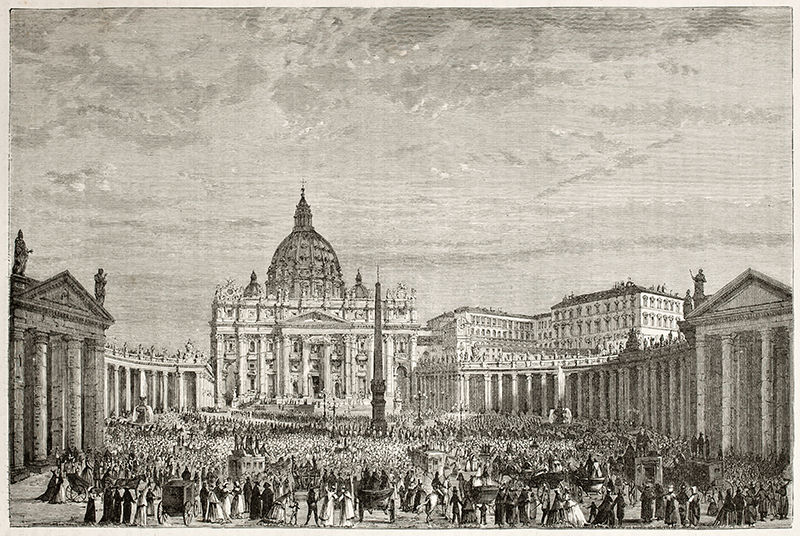The announcement by Benedict XVI on Feb. 11, 2013, that he intended to resign as pope the following Feb. 28 took the world by surprise. The last pope who willingly resigned was St. Celestine V, who stepped down on Dec. 13, 1294, after being pope for just over five months. However, the last time a pope resigned was in 1415. The reason why Pope Gregory XII resigned that year was to bring about a healing to the open festering wound in the then Church, when there were three men claiming to be the legitimate Bishop of Rome (pope).
Gregory XII’s renouncement of the papacy, carried out under a lot of pressure from both religious and secular leaders, was specifically aimed to end the Western Schism (1378-1417), which had created havoc at the highest level of the Church: the papacy itself. It is important to keep in mind that this schism did not create any heresy in Church doctrine, but it surely made a profound mess in identifying who was governing the Church.
However, Benedict XVI’s resignation was not to end some division in the Church but, as he personally stated, was due to his lack of strength of mind and body because of his advanced age. He reached this absolutely free decision for the good of the Universal Church. When Gregory XII resigned, the ensuing conclave took place after his death in 1417. On the other hand, the successor to Benedict XVI was elected 13 days after the resignation took effect. Cardinal Jorge Mario Bergoglio, SJ, was elected on March 13, 2013.
People in today’s society might think that a pope has always been elected in the Sistine Chapel, despite the fact that they know it was constructed about 600 years ago! They might believe that white smoke from the famous chimney has always signaled that the Roman Catholic Church has a new pope. Furthermore, they might conclude that cardinals have always elected popes.
In fact, the history of how men became popes since the time of Peter has been full of fascination, intrigues, conjecture, extraordinary expectations, violence, high-handed sheer secular politics, personal and family ambitions, and the interference of secular powers for many centuries. It proves that the Lord is in charge of the Church for the simple fact that, if it was left up to human beings, she would have disappeared centuries ago.
The essential difference between running a worldwide secular organization and the worldwide Catholic Church is that the former lacks the protection and guidance of the Holy Spirit. While great secular establishments are doomed to crumble and disappear due to scandals, inner struggles, corruption, incompetence and so forth, history has proven that the Catholic Church, though many times deeply wounded, is guaranteed survival by divine assurance.
A singular event that marked the beginning of what would eventually evolve into the way a pope is elected nowadays took place on April 13, 1059, when Pope Nicholas II — during his short 30-month papacy — issued a Papal Bull entitled “In Nomine Domini,” which began to regulate the valid canonical (legal) procedures for a conclave.
For the first of almost 13 centuries in the Church, popes were not elected under lock and key — in conclave. A papal election or appointment, in fact, was a very public affair for many centuries. The method by which a man ascended the papal chair depended much on what was going on in both society at large as well as in the City of Rome and the city’s current magnates.
There were times when there were two simultaneous papal elections carried out by conflicting parties. Long interregnums were not uncommon for many centuries, some due to delays of approval of the pope-elect by an emperor or king, others due to bitter bickering among the cardinal-electors, and still other due to some cardinal waiting for instructions from his secular ruler.
Secrecy in papal elections is a rather recent innovation. Direct secular interference in conclaves only disappeared at the beginning of the 20th century. There were times when secular rulers imposed their objection against a papal candidate. Nonetheless, for most of the last eight centuries, the election to the most absolute spiritual power in the world has been carried out in a most democratic way! The most recent definitive reform that had a direct influence on papal elections was introduced by Blessed Paul VI, when, in 1970, he legislated that cardinals over 80 years of age are no longer able to vote at a conclave.
In “Not Always Under Lock and Key: History of the Elections of Popes,” I present a narrative of how men have come to ascend the office of pope, beginning with the direct appointment of St. Peter by the Lord and down to the election of our current Pope Francis. The narrative is based on extensive research through vast multilingual literature and documents found in various Vatican institutions and beyond.
The book narrates the very complicated answer to a rather simple question: How have men become popes, beginning with the first pope, St. Peter?
Msgr. Spiteri is a priest of the Archdiocese of Los Angeles and currently serving at the Holy See.

